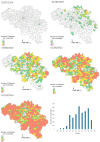Impact of BTV-3 Circulation in Belgium in 2024 and Current Knowledge Gaps Hindering an Evidence-Based Control Program
- PMID: 40284964
- PMCID: PMC12031096
- DOI: 10.3390/v17040521
Impact of BTV-3 Circulation in Belgium in 2024 and Current Knowledge Gaps Hindering an Evidence-Based Control Program
Abstract
Between 2006 and 2010, northwestern Europe experienced its first significant bluetongue virus (BTV) outbreak, driven by the spread of BTV-8, which had major repercussions on the European livestock sector. While BTV-3 was first identified in Europe in Italy in 2017, a new introduction of the virus was reported in 2023, in the Netherlands, and subsequently spread rapidly across the continent. A limited number of BTV-3 outbreaks were notified in Belgium in 2023, leading to the loss of its BTV-free status. In the following year, 2024, the virus spread throughout the country in a short time period. This study describes the impact of BTV-3 circulation in Belgium in 2024, detailing both its geographic spread and the associated increase in mortality, reduced births recorded, and decline in milk production among ruminants. Furthermore, preliminary results on the effectiveness of field vaccination and maternal immunity transfer are presented, as well as critical gaps that hinder the development of a robust, evidence-based management strategy. As the epidemiological situation is expected to become more complex in the future, due to the co-circulation of multiple BTV serotypes and other Culicoides-borne diseases, such as EHDV, effective collaboration and communication among stakeholders and international authorities will be crucial for implementing measures to mitigate the spread of these diseases.
Keywords: animal health; bluetongue; epidemiology; vaccination; vector-borne disease; virology.
Conflict of interest statement
The authors declare no conflicts of interest.
Figures







Similar articles
-
Monitoring of Schmallenberg virus, bluetongue virus and epizootic haemorrhagic disease virus in biting midges in Germany 2019-2023.Parasit Vectors. 2025 Jul 5;18(1):262. doi: 10.1186/s13071-025-06913-w. Parasit Vectors. 2025. PMID: 40618098 Free PMC article.
-
The Global Burden of Emerging and Re-Emerging Orbiviruses in Livestock: An Emphasis on Bluetongue Virus and Epizootic Hemorrhagic Disease Virus.Viruses. 2024 Dec 26;17(1):20. doi: 10.3390/v17010020. Viruses. 2024. PMID: 39861809 Free PMC article. Review.
-
Bluetongue virus serotype 3 in ruminants in the Netherlands: Clinical signs, seroprevalence and pathological findings.Vet Rec. 2024 Aug 17;195(4):e4533. doi: 10.1002/vetr.4533. Epub 2024 Aug 15. Vet Rec. 2024. PMID: 39148262
-
Serological Evidence of Bluetongue Virus Serotypes Circulating in Pakistan.Intervirology. 2025;68(1):57-66. doi: 10.1159/000546965. Epub 2025 Jun 24. Intervirology. 2025. PMID: 40555218 Free PMC article.
-
Seroprevalence and risk factors of bluetongue virus in domestic cattle, sheep, goats and camels in Africa: a systematic review and meta-analysis.Vet Q. 2024 Dec;44(1):1-12. doi: 10.1080/01652176.2024.2396118. Epub 2024 Aug 30. Vet Q. 2024. PMID: 39210745 Free PMC article.
References
-
- WOAH Terrestrial Manual 2021. Chapter 3.1.3. Bluetongue (Infection with Bluetongue Virus) [(accessed on 6 March 2025)]. Available online: https://www.woah.org/fileadmin/Home/fr/Health_standards/tahm/3.01.03_BLU....
MeSH terms
LinkOut - more resources
Full Text Sources
Research Materials

